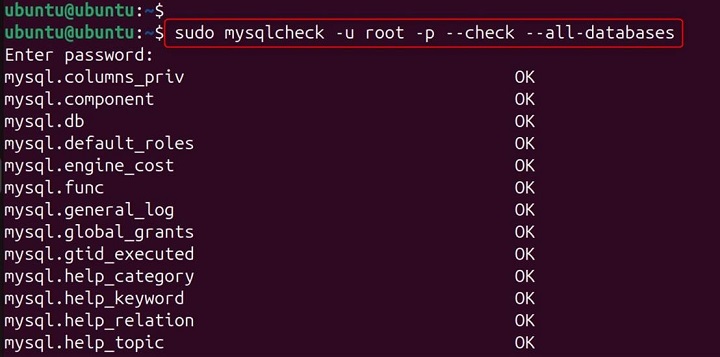
mysqlcheck Command in Linux
mysqlcheck is used to perform maintenance tasks on MySQL tables. It can check the integrity of tables, repair corrupted tables, optimize tables for better performance, and analyze tables to update index statistics. The utility works with MyISAM and InnoDB tables and can be run while the MySQL server is running.
Table of Contents
Here is a comprehensive guide to the options available with the mysqlcheck command −
Understanding mysqlcheck Command
mysqlcheck is a command-line utility provided by MySQL that allows you to check, repair, optimize, and analyze tables in a MySQL database. It is a powerful tool for database administrators to maintain the health and performance of their databases.
How to Use mysqlcheck Command in Linux
Before using mysqlcheck, you need to have MySQL installed on your Linux system. mysqlcheck is included with the MySQL server package. If it's not already installed, you can install it using your package manager.
Installation
For Debian-based systems (e.g., Ubuntu) −
sudo apt update sudo apt install mysql-server

For Red Hat-based systems (e.g., CentOS) −
sudo yum install mysql-server
Verify installation −
which mysqlcheck

Basic Usage of mysqlcheck
The basic syntax for using mysqlcheck is as follows −
mysqlcheck [options] database [tables]
Checking Tables
To check the integrity of tables in a database, use the --check option. This option verifies the structure and contents of the tables.
sudo mysqlcheck -u root -p --check mydatabase

This command will prompt you for the root user's password and then check all tables in the mydatabase database.
Repairing Tables
If you find any issues with the tables, you can repair them using the --repair option. This option attempts to fix any problems found in the tables.
sudo mysqlcheck -u root -p --repair mydatabase

This command will prompt you for the root user's password and then repair all tables in the mydatabase database.
Optimizing Tables
To optimize tables for better performance, use the --optimize option. This option reorganizes the physical storage of table data and associated index data to reduce storage space and improve I/O efficiency.
sudo mysqlcheck -u root -p --optimize mydatabase

This command will prompt you for the root user's password and then optimize all tables in the mydatabase database.
Analyzing Tables
To analyze tables and update index statistics, use the --analyze option. This option helps the MySQL optimizer make better decisions about query execution plans.
sudo mysqlcheck -u root -p --analyze mydatabase

This command will prompt you for the root user's password and then analyze all tables in the mydatabase database.
Checking Specific Tables
You can specify specific tables to check, repair, optimize, or analyze by listing them after the database name.
sudo mysqlcheck -u root -p --check mydatabase table1 table2

This command will prompt you for the root user's password and then check the table1 and table2 tables in the mydatabase database.
Using Multiple Options
You can use multiple options together to perform several operations in one command.
mysqlcheck -u root -p --check --repair --optimize mydatabase

This command will prompt you for the root user's password and then check, repair, and optimize all tables in the mydatabase database.
Using mysqlcheck with All Databases
To perform operations on all databases, use the --all-databases option.
sudo mysqlcheck -u root -p --check --all-databases

This command will prompt you for the root user's password and then check all tables in all databases.
Using mysqlcheck with Specific Storage Engines
You can specify the storage engine for the tables you want to check, repair, optimize, or analyze using the --engine option.
sudo mysqlcheck -u root -p --check --engine=InnoDB mydatabase

This command will prompt you for the root user's password and then check all InnoDB tables in the mydatabase database.
Using mysqlcheck with Verbose Output
To get more detailed output, use the --verbose option.
sudo mysqlcheck -u root -p --check --verbose mydatabase

This command will prompt you for the root user's password and then check all tables in the mydatabase database, providing detailed output.
Using mysqlcheck with Extended Check
For a more thorough check, use the --extended option. This option performs a more extensive check on the tables.
sudo mysqlcheck -u root -p --check --extended mydatabase

This command will prompt you for the root user's password and then perform an extended check on all tables in the mydatabase database.
Using mysqlcheck with Fast Check
To perform a quick check, use the --fast option. This option only checks tables that have not been closed properly.
sudo mysqlcheck -u root -p --check --fast mydatabase

This command will prompt you for the root user's password and then perform a fast check on all tables in the mydatabase database.
Using mysqlcheck with Medium Check
For a medium-level check, use the --medium-check option. This option performs a check that is more thorough than --fast but less extensive than --extended.
sudo mysqlcheck -u root -p --check --medium-check mydatabase

This command will prompt you for the root user's password and then perform a medium check on all tables in the mydatabase database.
Using mysqlcheck with Auto-Repair
To automatically repair tables if any issues are found, use the --auto-repair option.
sudo mysqlcheck -u root -p --check --auto-repair mydatabase

This command will prompt you for the root user's password and then check all tables in the mydatabase database and automatically repair any issues found.
Conclusion
mysqlcheck is a powerful and versatile tool for maintaining the health and performance of MySQL databases. It provides a wide range of options for checking, repairing, optimizing, and analyzing tables, making it an essential tool for database administrators.
By understanding and using the various options and commands available in mysqlcheck, you can effectively manage your MySQL server's tables and ensure the smooth operation of database.